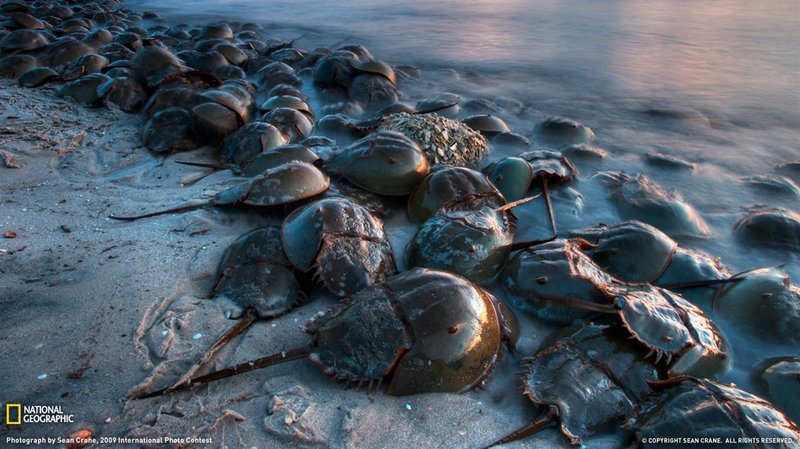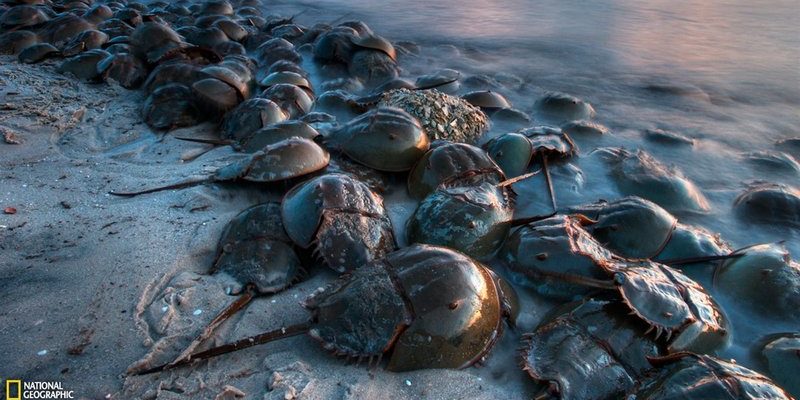
Imagine a creature that has been roaming the Earth for over 450 million years, long before even dinosaurs walked the planet. That’s the Horseshoe Crab, a fascinating marine animal that looks almost like a blend between a crab and a prehistoric artifact. At first glance, you might think they are simple animals, but there’s so much more beneath that hard exterior. They are more than just ancient wanderers of the ocean floor; they play a crucial role in our ecosystem and medicine.
The horseshoe crab is actually not a true crab at all! This animal belongs to a group called chelicerates, which also includes spiders and scorpions. Their unique body shape, with a hard shell resembling a horseshoe, is perfect for protection, while their long tail spine is often mistaken for a stinger. But don’t worry—these crabs aren’t out to get you. They are harmless and rather docile. Let’s dive deeper into the fascinating world of horseshoe crabs.
Physical Characteristics
The horseshoe crab is an interesting creature when it comes to physical appearance. They can grow up to 24 inches (61 centimeters) long, with a hard carapace that protects their body. This carapace is typically olive green or brown, allowing them to blend into their coastal habitat. The horseshoe crab’s tail, called a telson, can be as long as 10 inches (25 centimeters) and is primarily used to help right themselves if they flip over.
One of the most remarkable features of the horseshoe crab is its compound eyes. They have up to 10 eyes scattered across their bodies, including two large compound eyes on the sides of their carapace. These eyes can detect light and movement, making it easier for the horseshoe crab to navigate its environment. They’re not just pretty faces either—these eyes play a crucial role in their ability to avoid predators and find food.
Unique Body Structures
Horseshoe crabs have an interesting anatomy consisting of three main parts: the prosoma (head), the opisthosoma (abdomen), and the telson (tail). The prosoma is equipped with five pairs of legs that they use for movement, as well as for swimming and digging in the sand. Their legs also help them to find and consume their preferred diet of mollusks, worms, and other small invertebrates.
The opisthosoma houses their vital organs, and despite its armored appearance, it’s quite flexible. This flexibility allows them to move in their habitat and search for food more efficiently. The telson plays a lesser-known role but is still essential for balance. When horseshoe crabs find themselves upside down, they can use their telson to flip back over, which is crucial for their survival in such a dynamic environment.
Habitat and Distribution
You can typically find horseshoe crabs along the Atlantic coast of North America, particularly from Maine to Florida. They prefer shallow waters and sandy or muddy substrates where they can easily burrow. During mating season, which occurs in the spring and early summer, horseshoe crabs come ashore to mate and lay their eggs in the tidal zones.
These adaptable creatures also inhabit coastal marshes and estuaries, adapting to both saltwater and freshwater systems. They are particularly drawn to environments rich in food sources, which is why you might spot them in areas with thriving populations of clams and other tasty tidbits. Horseshoe crabs have a unique way of sensing their environment, using their sensitive legs and antennae to detect changes in water temperature and salinity.
Migration Patterns
Interestingly, horseshoe crabs are known for their seasonal migrations. They typically move to more shallow waters during the warmer months for feeding purposes and breeding. As temperatures drop in the fall, they move to deeper waters where they can avoid harsher weather conditions. This migration is critical for their survival and helps maintain their populations.
Diet and Feeding Habits
Horseshoe crabs are omnivorous, meaning they eat both plant and animal matter. Their diet primarily consists of mollusks, such as clams and oysters, as well as worms and other small invertebrates. They have specialized mouthparts that allow them to grind down their food while they filter through the sediment on the ocean floor.
You might wonder how these crabs find their food. Horseshoe crabs have a unique feeding strategy—they use their legs to rake through the sandy bottom, uncovering hidden morsels. They have a keen sense of taste and can detect chemicals released by their prey, making them effective foragers in their habitat.
Reproductive Behavior
During the breeding season, horseshoe crabs engage in a fascinating courtship dance. Males typically arrive at the shore first, waiting for females to come ashore to lay their eggs. When a female arrives, she attracts several males, who then clasp onto her shell using their pedipalps. This can sometimes result in “clumps” of males surrounding a single female, creating quite a spectacle.
Once the female is ready to lay her eggs, she digs a hole in the sand and deposits thousands of eggs, which the males fertilize. The eggs are left to hatch on their own, relying on the safety of the sand and the sun’s warmth to help them develop. Young horseshoe crabs will stay in shallow waters for their early development before venturing into deeper waters as they grow.
Conservation Status
Despite their resilience over millions of years, horseshoe crabs are facing threats today. Overharvesting for bait and medical research has led to a decline in their populations. Their blue blood is incredibly valuable for testing the safety of vaccines and medical equipment, making them targets for biomedical companies. Additionally, habitat destruction and climate change pose serious risks to their survival.
Conservation efforts are underway to protect horseshoe crab populations. Organizations are working to create sustainable practices for harvesting these creatures, ensuring that they can continue to thrive in their natural habitats. Public awareness campaigns are also essential in educating people about the importance of horseshoe crabs in our ecosystem.
Importance to Ecosystems
The impact of horseshoe crabs extends beyond their immediate environment. They play a vital role in the food web, serving as food for a variety of birds, fish, and other marine animals. Their eggs are an essential energy source for migratory birds, particularly during spring migration. When horseshoe crabs spawn, they provide a buffet of nutrients that helps fuel the survival of many species.
Moreover, horseshoe crabs contribute to maintaining healthy ocean ecosystems. As they burrow into the sand and sift through sediments, they help aerate the soil, promoting a balanced habitat for other marine creatures to thrive.
Fun Facts About Horseshoe Crabs
- Horseshoe crabs are more closely related to spiders than crabs!
- They can live up to 20 years in the wild.
- Horseshoe crab blood is blue due to the presence of copper-based hemocyanin.
- They can regenerate lost limbs, much like some species of starfish.
- Horseshoe crabs have existed longer than dinosaurs!
FAQ
What do horseshoe crabs eat?
Horseshoe crabs primarily feed on small invertebrates like mollusks, worms, and crustaceans. They use their specialized mouthparts to grind their food while sifting through sediment on the ocean floor. This diet helps them thrive in their coastal habitats, where they can find plenty of food sources.
Are horseshoe crabs dangerous to humans?
No, horseshoe crabs are not dangerous to humans. They have a hard shell for protection but do not possess any stinging mechanisms like some other marine animals. If you encounter one, it’s best to observe from a distance, as they are harmless and play an important role in their ecosystem.
How do horseshoe crabs reproduce?
Horseshoe crabs reproduce by mating in shallow waters. Males clasp onto females during the breeding season, and when the female lays her eggs in the sand, males fertilize them. A single female can lay thousands of eggs, which are left to develop on their own.
Why is horseshoe crab blood valuable?
The blood of horseshoe crabs is blue and contains a substance called Limulus Amebocyte Lysate (LAL), which is critical for testing the sterility of medical equipment and vaccines. This unique property has led to their overharvesting for biomedical purposes, which raises concerns for their survival.
How can we help protect horseshoe crabs?
To help protect horseshoe crabs, you can support sustainable fishing practices, advocate for habitat conservation, and raise awareness about their importance in ecosystems. Additionally, you can help by choosing products that do not contribute to the overharvesting of horseshoe crabs.
What are the main threats to horseshoe crab populations?
Main threats to horseshoe crab populations include overharvesting for bait and medical use, habitat destruction, and the impacts of climate change. These threats can significantly affect their breeding and feeding grounds, leading to declining numbers in the wild.
Can horseshoe crabs regenerate lost limbs?
Yes! Horseshoe crabs have the ability to regenerate lost limbs. If they lose a leg due to predation or injury, they can regrow it over time, much like some species of starfish. This ability helps them survive in their natural environments.
Are horseshoe crabs migratory creatures?
Yes, horseshoe crabs are known to migrate to shallow waters during the warmer months for feeding and breeding purposes. As temperatures drop, they move to deeper waters to avoid harsh weather, demonstrating their adaptability to changing conditions.
How long do horseshoe crabs live?
Horseshoe crabs can live for up to 20 years in the wild. This longevity allows them to contribute significantly to their ecosystems over time, but their populations are still threatened due to human activities and environmental changes.
Where can I find horseshoe crabs?
You can typically find horseshoe crabs along the Atlantic coast of North America, particularly in shallow waters and coastal regions. They prefer sandy or muddy bottoms, making beaches and estuaries ideal places to observe these ancient creatures.

